|
|
|
Sort Order |
|
|
|
Items / Page
|
|
|
|
|
|
|
| Srl | Item |
| 1 |
ID:
102921
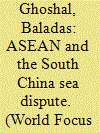

|
|
|
| 2 |
ID:
102930
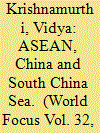

|
|
|
| 3 |
ID:
104652
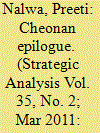

|
|
|
|
|
| Publication |
2011.
|
| Summary/Abstract |
The 'Cheonan' incident has prodded and expedited the strategic comeback of the US in East Asia. The US offer to mediate the territorial disputes over islands and seabed minerals in the South China Sea at the ASEAN Regional Forum (ARF) meeting in July 2010 has provoked harsh criticism from the Chinese. This US diplomatic move appears to be a premeditated one to substantially diminish the influence of China in the region, to re-secure its own strategic forward military presence and to signal that it is not yet time for China to acquire absolute control over this critical waterway. The episode has rendered their mercurial relationship more problematic and makes the G-2 paradigm a fallacy.
|
|
|
|
|
|
|
|
|
|
|
|
|
|
|
|
| 4 |
ID:
102922
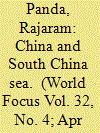

|
|
|
| 5 |
ID:
102926
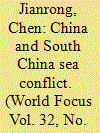

|
|
|
| 6 |
ID:
098477
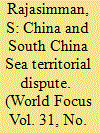

|
|
|
| 7 |
ID:
102925
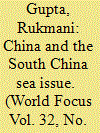

|
|
|
| 8 |
ID:
124666
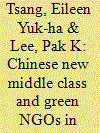

|
|
|
|
|
| Publication |
2013.
|
| Summary/Abstract |
By examining the emerging Chinese new middle class as well as green non-governmental organisations (NGOs), this study finds that while the emergence of the Chinese new middle class facilitates the growth of green NGOs, the Chinese new class are not activists or agitators working against the government. Based on in-depth interviews with leaders of green NGOs in Guangdong Province, this research examines why green NGOs founded by the Chinese new middle class do not call for or advocate environmental protection. It concludes that contrary to conventional wisdom, the Chinese new middle class is a vanguard of guanxi (connections)-seeking, but a laggard in promoting environmental protection and civil-society activism. Green NGOs are principally used as a tool to cultivate social capital in the form of guanxi in order to promote personal material interests.
|
|
|
|
|
|
|
|
|
|
|
|
|
|
|
|
| 9 |
ID:
109780
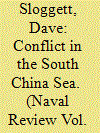

|
|
|
| 10 |
ID:
098934


|
|
|
| 11 |
ID:
175569
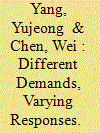

|
|
|
|
|
| Summary/Abstract |
While Chinese local governments remain extremely wary of workers’ collective actions, they do not always suppress them; sometimes, they tolerate such actions and even seek to placate workers. What accounts for these different government responses to workers’ collective actions? Based on a sample of over 1,491 collective action cases that took place in Guangdong between 2011 and 2016, we find that the types of demands raised by workers during collective actions affect how local governments respond. Local governments are likely to forcefully intervene in collective actions in which workers make defensive claims concerning issues of payment. In contrast, local governments are likely to use non-forceful approaches in response to actions in which workers make defensive claims regarding social security.
|
|
|
|
|
|
|
|
|
|
|
|
|
|
|
|
| 12 |
ID:
163155
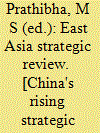

|
|
|
|
|
| Publication |
New Delhi, Pentagon Press, 2018.
|
| Description |
xiv, 262p.hbk
|
| Standard Number |
9789386618658
|
|
|
|
|
|
|
|
|
|
|
|
Copies: C:2/I:0,R:0,Q:0
Circulation
| Accession# | Call# | Current Location | Status | Policy | Location |
| 059576 | 327.51/PRA 059576 | Main | On Shelf | General | |
| 059577 | 327.51/PRA 059577 | Main | On Shelf | General | |
|
|
|
|
| 13 |
ID:
105483
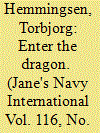

|
|
|
| 14 |
ID:
137500
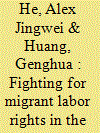

|
|
|
|
|
| Summary/Abstract |
China's dizzying economic achievement is not mirrored in its labor rights protection record. Migrant workers in particular do not enjoy rights commensurate with their contribution to the economy. The pervasive infringement of labor rights and the failure of the official protective system have jointly created a niche for nongovernmental organizations (NGOs). This article investigates the grassroots migrant labor NGOs in the Pearl River Delta region, an area which has seen unprecedented increases in labor disputes both in terms of quantity and intensity. Making extensive use of in-depth interviews and participatory observations, it examines the strategies and tactics NGOs use for survival and growth in a hostile external environment. This article reveals that administrative illegitimacy and resource shortage have been the two key challenges for grassroots NGOs; in order to survive, they have developed a series of strategies to enhance legitimacy and explore resources. In the meantime, however, antagonistic thinking still drives the government's response to grassroots organizations unless the latter can skillfully balance political ideology and actual operation. Yet, overall, most NGOs still managed to survive despite various difficulties. Reciprocity and mutual trust are of critical importance to peaceful coexistence, if not cooperation, between the state and the grassroots. The building of long-term healthy labor relations in China necessitates more liberal thinking and collaborative governance.
|
|
|
|
|
|
|
|
|
|
|
|
|
|
|
|
| 15 |
ID:
141401
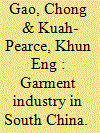

|
|
|
|
|
| Summary/Abstract |
Since the implementation of China’s economic reform and opening-up policy at the end of the 1970s, garment manufacturing for both the domestic and global markets has developed and proliferated quickly in Guangzhou-centred South China. It is believed to be the result of the industrial restructuring of the global apparel commodity chain and a large domestic consumer demand from the Chinese people. Compared with other industries, the garment industry has long been subject to the strong impact of a transitional market economy and, more recently, the increasingly rapid process of marketisation in China. In order to provide a clear sociological conceptualisation of the market economy in the reform era, this paper aims to apply the relational work approach to analysing economic transactions in the garment business, particularly business dealings between garment producers and wholesalers. The focus is on their continued efforts to make appropriate economic arrangements in accordance with specific sets of social relations through continuous relational work. This paper will examine three categories of relational work and the associated economic forms in the making. First, it will explore families and the household economy; second, it will examine relatives and friends and the favour-based economy; and third, it will study strangers and the market economy. Through the use of this relational work framework, this paper will shed light on how the different sets of relational work help us to understand relationships and embeddedness between garment producers and wholesalers in China’s rapidly evolving garment economy.
|
|
|
|
|
|
|
|
|
|
|
|
|
|
|
|
| 16 |
ID:
131571
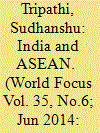

|
|
|
|
|
| Publication |
2014.
|
| Summary/Abstract |
The emerging economic cooperation between India and ASEAN nations will be a great achievement for both the partners and will demonstrate enough potential for an ever increasing multifarious partnership, leading to all round growth and prosperity. Furthermore, the cooperation between them will add to their collective power with which they can effectively stand against the rising menace of terrorism and other socio-economic and political challenges in the East. Also, their unity and strength will deter outside powers from intervening into their internal affairs and will work as a strong regional bulwark against undue sovereign claims by China over entire South China Sea and also over territories of almost all of the ASEAN nations, particularly, Vietnam and Philippines and the same holds good in case of Japan and South Korea as regards territories of East China Sea and also other adjacent areas respectively.
|
|
|
|
|
|
|
|
|
|
|
|
|
|
|
|
| 17 |
ID:
089981
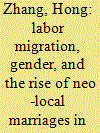

|
|
|
|
|
| Publication |
2009.
|
| Summary/Abstract |
In the past two decades, migration has become a quintessential feature defining the identity and life experiences of millions of young rural women who have left their home villages and migrated to urban areas for wage labor in China. However, due to the combined effects of the state-instituted hukou system and women's traditional gender roles of childcare and household duties, many female migrants face difficult choices when it is time for them to get married. In this study I examine the rise of a new marriage form among migrant couples in Dongguan, a newly industrializing boomtown in the Pearl River Delta of Guangdong province. I call this marriage a neo-local marriage as migrant couples set up their post-marital residence in a destination locale that is thousands of miles away from their hometowns. I first describe some of the new features of neo-local marriages for young migrant couples in Dongguan. I then explore Dongguan's boomtown status in the new economy, the changing labor market, and young migrants' agency as new forces behind the rise of this new marriage form. Finally I discuss both the potential transformative power of a neo-local marriage for young female migrants and the risks and constraints of this marriage for them as well.
|
|
|
|
|
|
|
|
|
|
|
|
|
|
|
|
| 18 |
ID:
089755


|
|
|
|
|
| Publication |
2009.
|
| Summary/Abstract |
In this study, we argue that the specific process of the proletarianization of Chinese migrant workers contributes to the recent rise of labour protests. Most of the collective actions involve workers' conflict with management at the point of production, while simultaneously entailing labour organizing in dormitories and communities. The type of living space, including workers' dormitories and migrant communities, facilitates collective actions organized not only on bases of locality, ethnicity, gender and peer alliance in a single workplace, but also on attempts to nurture workers' solidarity in a broader sense of a labour oppositional force moving beyond exclusive networks and ties, sometimes even involving cross-factory strike tactics. These collective actions are mostly interest-based, accompanied by a strong anti-foreign capital sentiment and a discourse of workers' rights. By providing detailed cases of workers' strikes in 2004 and 2007, we suggest that the making of a new working class is increasingly conscious of and participating in interest-based or class-oriented labour protests.
|
|
|
|
|
|
|
|
|
|
|
|
|
|
|
|
| 19 |
ID:
124640
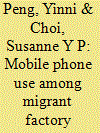

|
|
|
|
|
| Publication |
2013.
|
| Summary/Abstract |
Comparing ethnographic and interview data in three contrasting production arrangements in a labour-intensive factory in South China, this article argues that while the mobile phone constitutes a new contested terrain on the shop floor and facilitates control and resistance between capital and labour simultaneously, the dynamics of control and resistance is contingent upon the exact arrangements of production. While the management strictly prohibit line operators in the assembly line department from using their mobile phones, they turn a blind eye towards mobile phone use among workers in the hardware department, and mandate mobile workers who are not fixed at work stations in both departments to use mobile phones. Diverse managerial control tactics have generated different patterns of worker resistance. Workers in the assembly line department employ strategies to evade managerial surveillance and continue to use mobile phones at work covertly. They also contest the double standards of mobile phone use displayed by the management. Workers in the hardware department challenge the boundaries of legitimate mobile phone use, and mobile workers use tactics to escape being tracked down by the management via their mobile phones. Mobile phones also facilitate the strategy of resistance through exit among all workers.
|
|
|
|
|
|
|
|
|
|
|
|
|
|
|
|
| 20 |
ID:
173855
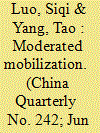

|
|
|
|
|
| Summary/Abstract |
In response to a series of strikes in south China in 2010, a new model of collective bargaining has emerged, featuring what this article describes as “moderated mobilization.” Distinct from what is typically known as China's quadripartite industrial relations system, whereby workers are separated from the party-state, official trade unions and employers, this model shows workers and enterprise-level trade unions in collaboration with one another. According to our observations from 2012 to 2017, some enterprise unions have successfully mobilized workers throughout the collective bargaining process. These unions are democratically elected by workers and are relatively independent from the official authorities. At the same time, they have “moderated” such mobilization particularly to reduce labour militancy, given the political and institutional constraints within which they must work. The implication of this new model is significant. Although it might be far from solving the quadripartite dilemma, it has signalled an increase in local initiatives among enterprise unions – a previously neglected but pragmatically favourable channel for workers.
|
|
|
|
|
|
|
|
|
|
|
|
|
|
|
|
|
|
|
|
|